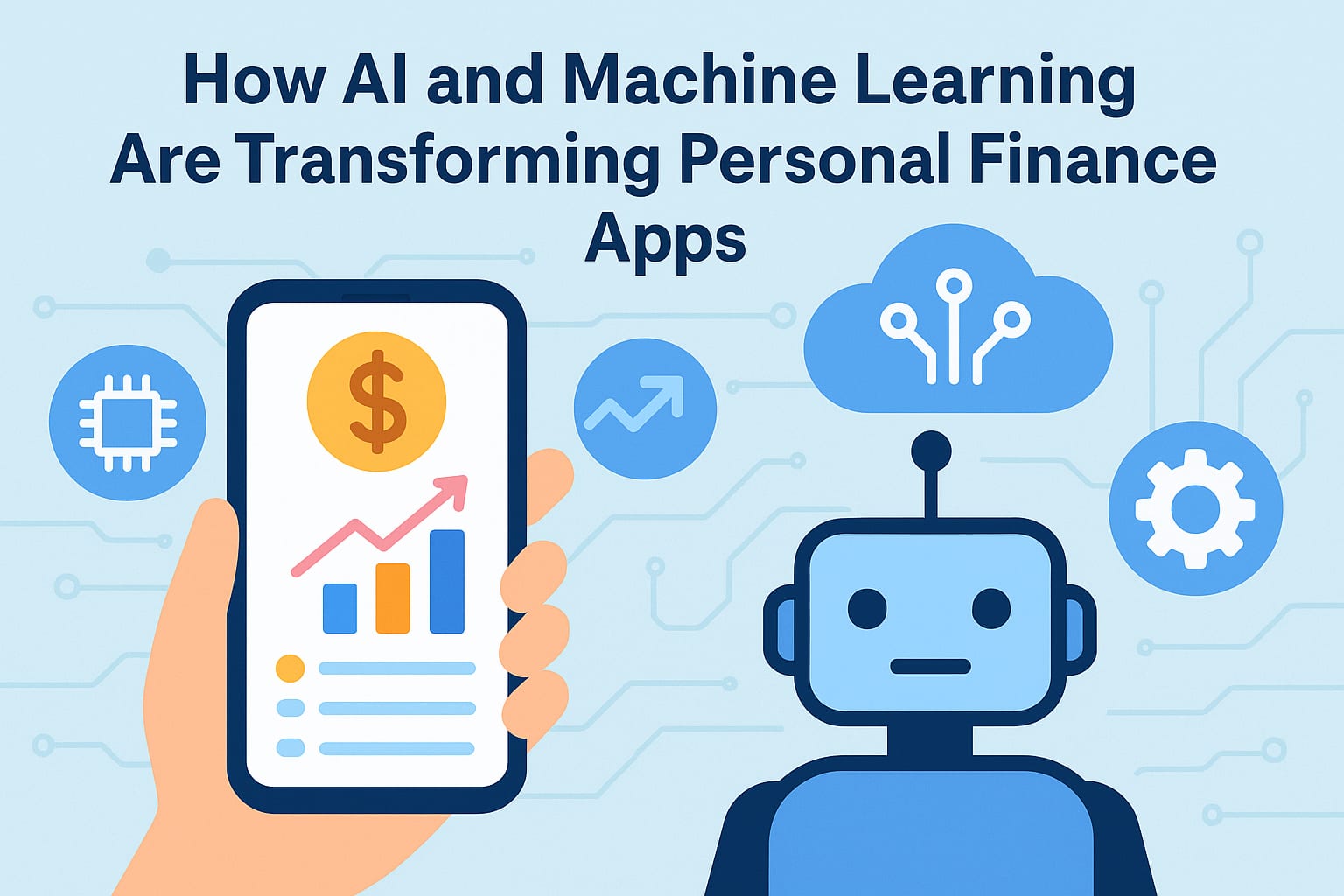In recent years, personal finance has moved far beyond spreadsheets and manual budgeting tools. Thanks to breakthroughs in artificial intelligence (AI) and machine learning (ML), a new generation of apps is emerging—ones that don’t just track spending, but actively advise, predict, and personalize users’ financial journeys. Whether you’re building a budgeting tool or working with a fintech app development company, the transformation is both deep and wide-ranging. Below, we explore how AI and ML are reshaping personal finance apps, and what that means for users and developers alike.
From Passive Tracking to Active Guidance
Traditional personal finance apps primarily offered two functions: log transactions and display visualizations of those logs. However, today’s leading apps use ML to automatically categorise spending, detect patterns, and deliver actionable insights. For example, many apps now employ machine learning algorithms to recognise recurring transactions, flag unusual or risky spending, and forecast future cashflow. According to industry reports, AI-powered personal finance tools now categorise up to 95 % of transactions automatically.
This shift means that users no longer need to spend time tagging each purchase or analysing spreadsheets. The app becomes a proactive adviser: “You spent more this month on dining out; here’s how you can reduce it by 15 % next month.” That kind of real-time coaching is a direct result of ML models learning user behavior and then tailoring advice accordingly.
Predictive Analytics and Forecasting
One of the most powerful applications of machine learning in personal finance apps is predictive forecasting. Using historical data—such as income patterns, previous spending, and savings behavior—ML models can estimate future cash flows, highlight approaching risks, and suggest corrective actions. For instance, an app might predict that the user’s checking account will drop below a safe threshold in two weeks, and proactively recommend reducing discretionary spending or transferring funds.
For developers and product teams, this means that in the realm of financial application development, embedding predictive ML requires access to reliable, cleaned data and robust models. But when done correctly, the experience shifts from retrospective reporting (“Here’s what you spent last month”) to forward-looking advice (“Here’s what you should do next”).
Personalized Financial Coaching
Beyond predictions, AI enables personalization at scale. Machine learning models can segment users by behavior: big savers, frequent spenders, new earners, debt-heavy users, and so on. Based on these profiles, the application can deliver tailored advice—such as debt-payoff strategies, savings goal adjustments, or investment reminders. In essence, the app becomes more than a tool—it becomes a financial coach aware of your unique situation.
For teams engaged in custom fintech app development, implementing this personalization means designing systems where user feedback (manual corrections, goal updates) is fed back into the models so the app increasingly fits the user’s evolving financial life. The result: higher engagement, better user outcomes, and ultimately, stronger retention.
Automation and Intelligent Workflows
Another dimension where AI shines is automation. In the world of fintech, users expect seamless flows: linking bank accounts, scanning receipts, auto-categorising transactions, and setting up rules for savings or bills. Machine learning accelerates these workflows. For example, optical character recognition (OCR) combined with ML can scan a receipt, extract relevant data (merchant, amount, date), and categorise it automatically.
Automation isn’t just a “nice to have”—it’s increasingly a baseline expectation. For any fintech startup or enterprise product delivered by a fintech app development company, automating tedious user tasks frees up the user to focus on decision-making rather than data entry.
Fraud Detection and Risk Management
With increased connectivity to bank accounts and financial instruments comes an elevated risk profile. Users demand both convenience and security—and here AI and ML are key. Machine learning models trained on transaction data can detect anomalies (e.g., unusual location, time, or amount of spending) that indicate fraud or misuse. They can also analyse patterns of behavior to spot early signs of financial stress or potentially risky borrowing.
From a development perspective, integrating such risk-based ML models demands not only strong model training but also robust data governance, privacy compliance, and real-time alerting capabilities. The promise: a personal finance app that is both smart and safe.
Enhancing User Experience with Conversational Interfaces
Another trend: conversational AI and chatbots embedded within personal finance apps. Instead of users navigating menus, they can just ask, “How much did I spend on coffee last month?” or “Should I save $200 this month or invest it?” The ML-driven NLP engine interprets the query, fetches the relevant data, and delivers a customised answer.
Conversational interfaces lower the barrier for everyday users, enabling them to engage with complex financial data using natural language. For developers, this moves the focus from flashy dashboards to intuitive dialogue flows and rich context-aware responses.
Democratizing Access to Financial Advice
Arguably one of the most impactful effects of AI in personal finance is the democratization of access. Previously, sophisticated financial advice—personal budgeting plans, investment pathing, debt fusion strategies—was mostly reserved for high-net-worth individuals working with advisers. Now, thanks to ML-driven insight engines built into consumer apps, many of those capabilities are accessible to average users. The value proposition broadens: “You don’t need a financial advisor—your phone is your coach.”
For companies building new tools in the space, this means opportunities to serve under-represented demographic groups—students, freelancers, emerging professionals—with customized, automated financial guidance.
Developer and Business Implications
For businesses building next-gen personal finance apps, the implications of AI/ML integration are substantial. Here are some key considerations:
- Data Strategy & Quality: Machine learning is only as good as the data it trains on. Collecting, cleaning, and managing transaction, account, and user-behavior data is foundational.
- Model Training & Evolution: Models need continuous retraining—not just initial launch. Behavioral patterns shift, economics change, categories evolve.
- Ethics & Privacy: Financial data is extremely sensitive. Developers must ensure compliance with regulations (GDPR, CCPA), embed ethical frameworks for ML decisions, and maintain transparency in model behavior.
- UX Integration: AI features shouldn’t feel tacked on—they should enhance the core product experience. For example, insights must be simple, timely, and actionable.
- Scalability & Performance: Real-time insights and alerts require robust infrastructure—especially when users expect instant, automated responses.
- Monetisation Models: With added intelligence, developers and businesses might explore subscription tiers for “premium insights,” or white-label solutions for banks and credit unions.
By engaging strategically with these dimensions, any team—whether a small startup or established fintech enterprise—can deliver powerful user-centric experiences.
Challenges and What’s Next
Despite the immense potential, challenges remain. Financial behavior is complex and often irrational. ML models must navigate ambiguity, incomplete data, and bias. Building truly accurate predictive models for individual financial futures is still nascent. Moreover, regulatory frameworks (data protection, algorithmic fairness) are still catching up.
On the horizon, we expect even deeper personalization: models that understand life changes (job loss, new baby, relocation), integrate alternative data (subscriptions, social activity, geo patterns), and surface insights via voice or AR interfaces. Apps will become more ubiquitous, adaptive, and embedded in everyday life.
Conclusion
AI and machine learning are not just incremental upgrades to personal finance apps—they’re enabling a paradigm shift from passive tracking to active financial stewardship. From automated categorization and predictive forecasting, to personalized coaching and real-time risk alerts, these intelligent features empower users in unprecedented ways.
For developers involved in custom fintech app development or partnering with a fintech app development company, now is the time to embrace AI/ML not as a buzzword, but as a core enabler. In doing so, they can build products that not only manage money—but shape financial behavior and outcomes.


